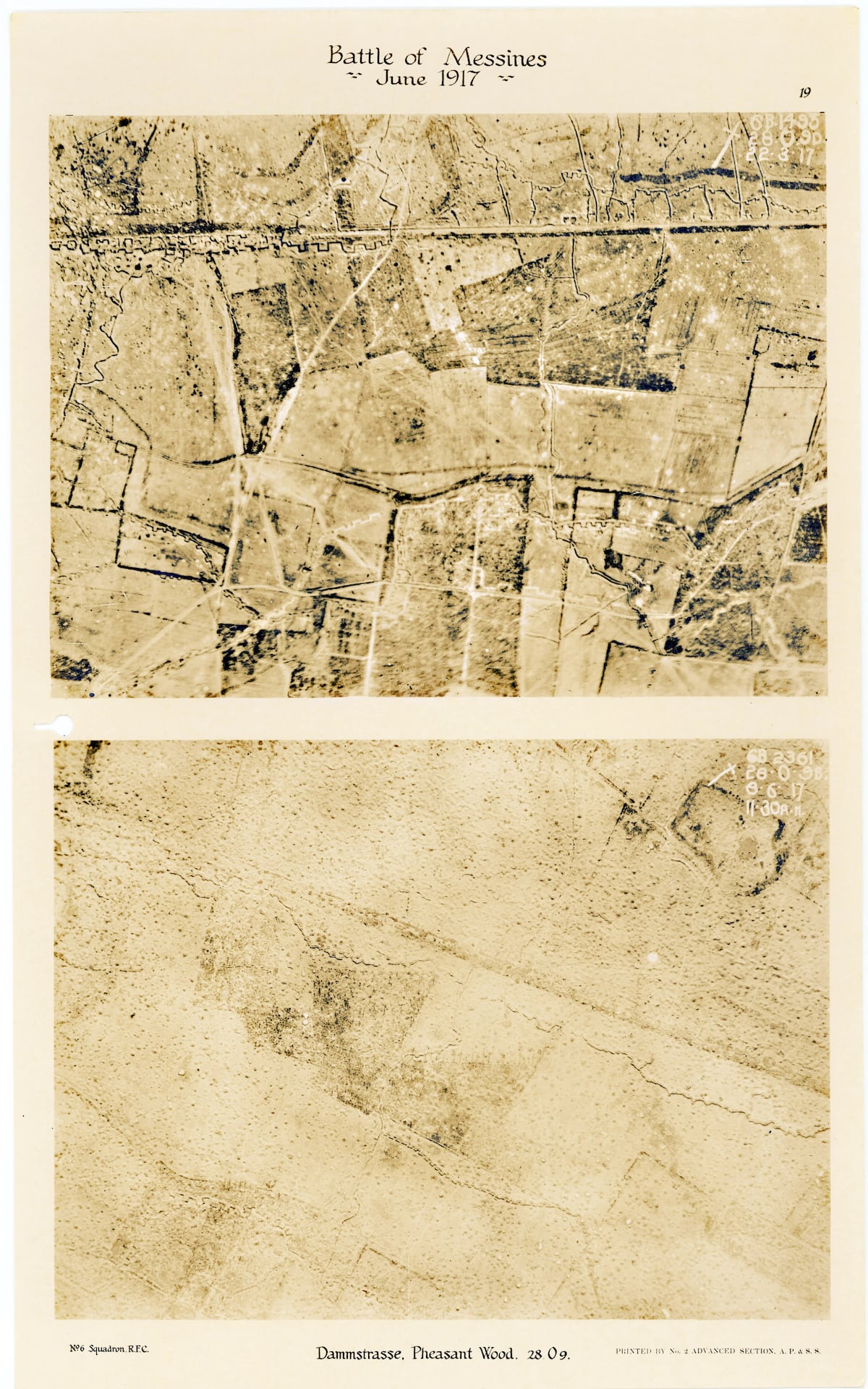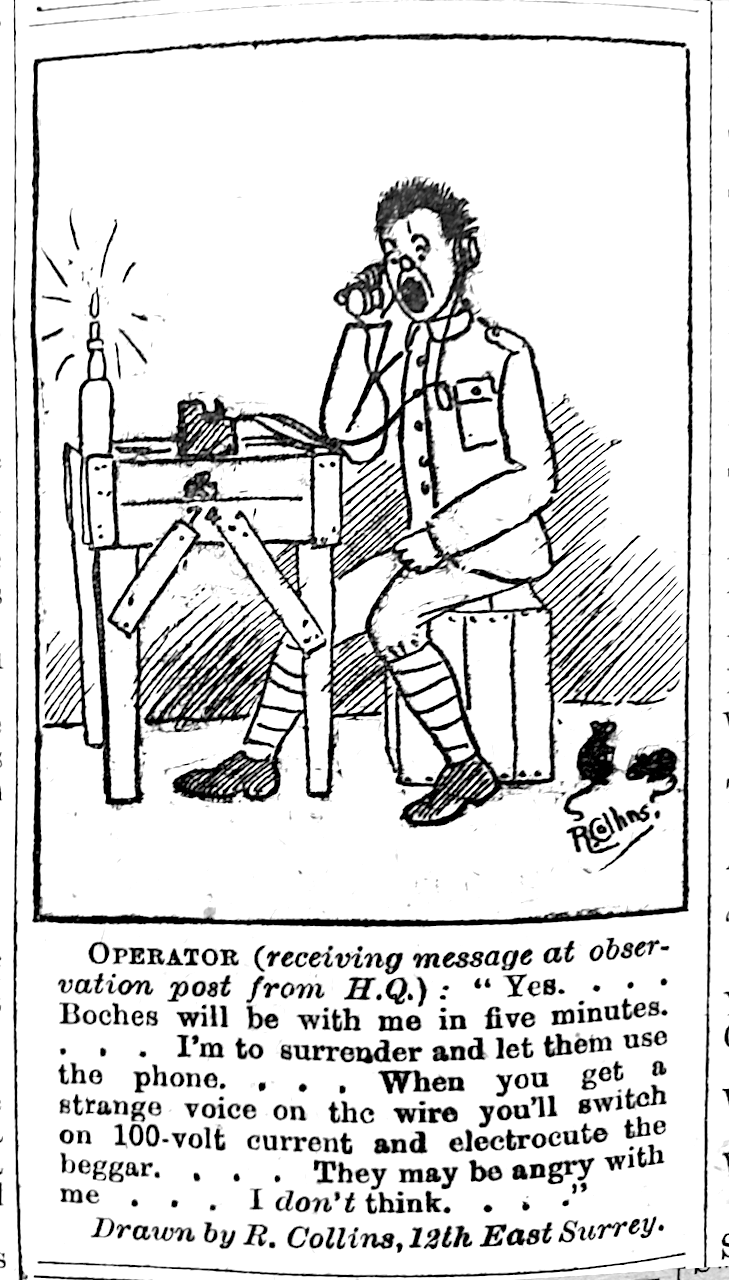Soldier-cartoonist: Private Richard Collins, 12th Battalion East Surrey
Private Richard Collins, 12th (Bermondsey) Battalion East Surrey Regiment
Service Number: 12906 (Later 12234, 1st Irish Guards)
Born: 9 August 1899, Brentford, Middlesex
Died: Unknown
Enlisted, at the age of 19, in August 1915 with the 12th (Bermondsey) Battalion East Surrey Regiment, earning the qualification of 1st Class Signaller (his civilian occupation was listed as labourer), the battalion was posted to the Western Front in May 1916. On 15 September that same year, the battalion would take part in the Battle of Flers-Courcelette, notable for the first use of tanks, and the battalion would suffer heavy casualties in the assault — the unit diary notes that they lost nearly all their officers.1 On the same day, Collins was promoted to Lance Corporal.

On 7 June 1917, the battalion was involved, as part of 41st Division, in the Battle of Messines Ridge — a position the Germans had held for two and a half years, where their objective was to attack and consolidate Dammstrasse (an elevated road that ran from the St. Eloi Road to the White Chateau, which the Germans had dug into) and the surrounding woods and positions. They came under enemy artillery fire, suffering a few casualties, as they moved to their jumping off position at 1.30am. At 3.10am, explosives that had been planted in 19 mines along the ridge were detonated and, at the same time, every available gun and howitzer opened fire on the enemy. The first wave, made by the 123rd Brigade accompanied by tanks, was able to capture every position on the Dammstrasse by 5.00am, and at 5.10am the 12th, East Sussex with the 122nd Brigade moved up to Dammstrasse, under enemy fire. They arrived at 6.00am, where they prepared for an assault to clear the enemy dugouts in Pheasant Wood and Denys Wood. They were supported by a creeping barrage, and at 6.30am the barrage preceded them; by 6.50am they began to move behind it, moving in 50-yard leaps.
By 7.15am, meeting a demoralised enemy and very little resistance, and taking many prisoners in the process, they cleared the dug-outs and trenches in the woods, allowing them to set up Battle HQ in a crater in Pheasant Wood, marking their position with a picture of a dagger tied to a stick. However, the creeping barrage dropped back as they tried to move forward and there were casualties caused by their own guns. Despite this, they were able to consolidate their position, setting up four advanced posts and an operation post in contact with the supporting aeroplanes by 8.30am. They then suffered from an intermittent bombardment of high explosives from the enemy and the unit diary notes they could have moved further and captured some of the hostile guns (in sight of 500 yds) if not for the barrages. Nevertheless, under such conditions they managed to further consolidate their ground, set up a signalling post, and establish communications with Brigade, which allowed 24th Division, at 3.10pm, to leapfrog them and take the final objectives of the day, which was achieved by 5.00pm.
Overall, the day was a great success, with the capture of over 7,200 prisoners, 51 guns, 242 machine guns, and other military stores. The 12th East Sussex alone took 268 prisoners, 6 machines guns, and two trench mortars. The cost was 6 officers and 23 other ranks killed, and 160 wounded (of whom 7 died soon after). One of the wounded was Richard Collins who suffered a gunshot wound to the neck and was invalided to England. Shortly afterwards, he transferred to the 1st Battalion Irish Guards and would return to the Western Front in March 1918 for three months, before returning to England in July, having been selected as a candidate for officer training, where he stayed until being demobbed in January 1919.2
For his conduct in the Battle of Messines Ridge, Collins was awarded the Military Medal for bravery in the field.3
It has not been possible to establish any further details about Collins after the war, but the drawing below was certainly drawn by him; based on the name, the regiment and his signature in the cartoon matching those in his records. The cartoon — and Collins himself — also had the distinction of being one of the first soldier-drawn cartoons to feature in Blighty.

Thanks to Steve 'Buster' Johnson, author of Over the Western Front, www.stevebusterjohnson.com, for the 6 Squadron aerial photograph.
Posts in this series
- Soldier-cartoonist: Corporal Harry Cotton, Meteorological Office, 4th Army HQ
- Soldier-cartoonist: Sapper Charles Albert Kennett, Royal Engineers
- Soldier-cartoonist: Private Louis Ollier, 8th Cheshire Regiment
- Soldier-cartoonist: Private Alfred Edmeades Bestall, Army Service Corps
- Blighty Mystery File No.1
- Soldier-cartoonist: Corporal Bertie Inward, 2/19th London Regiment
- Soldier-cartoonist: Private Richard Collins, 12th Battalion East Surrey
- Solider-cartoonist: Corporal Gontran De Tournoüer, 11th Field Artillery Brigade, Australian Imperial Force.
- Soldier-cartoonist: Lance Corporal Gilbert Tom Webster 26th Royal Fusiliers
- Soldier-cartoonist: Private Charles "Chas" William Holt, 16th Sherwood Foresters [Unconfirmed]
- Soldier-cartoonist: Corporal Robert Birrell, 17th Highland Light Infantry
- The ‘Budding Bairnsfathers’ : First World War Soldier-cartoonists Published in Blighty